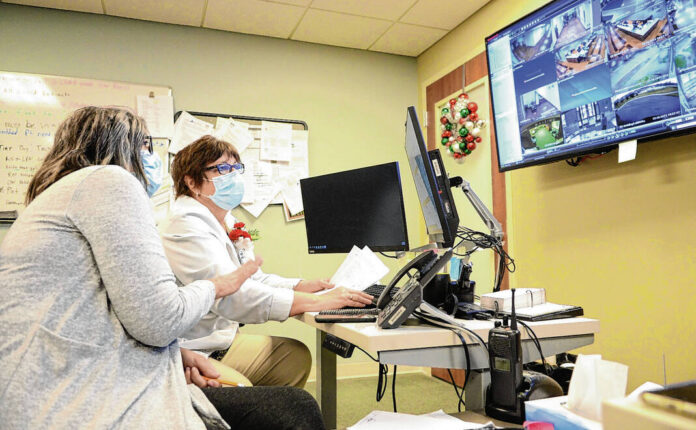
Joel Philippsen | CRH Photo Nursing Administrative Coordinators (NACs) Lynn Lutz, right, and Jennifer Willoughby discuss patient placements transfers and placements in the Command Center at Columbus Regional Hospital Thursday, Dec. 16, 2021.
Local health officials say they expect to see an increase in COVID-19 infections in the coming weeks as a more contagious version of the omicron variant that is already driving up cases in Europe and Asia makes its way across the United States.
However, officials do not anticipate a major surge like the one that overwhelmed the local health care system this past winter.
The new version of the coronavirus that public health officials are keeping an eye on, called the BA.2 subvariant, is a descendant of omicron but is about 30% more contagious than the original omicron strain.
BA.2 is already starting to gain ground in the United States, with the latest data from the Centers for Disease Control and Prevention showing the share caused by BA.2 is up significantly and accounted for about 35% of new infections in the last week, The Associated Press reported. In the Northeast, it was about half of all confirmed infections.
However, the CDC case counts likely underestimate the true numbers because some people are no longer getting tested, and others are testing at home and not reporting the results, according to wire reports.
“As the BA.2 subvariant starts spreading across the U.S., it should be expected that local cases will start to increase again,” said Bartholomew County Health Officer Dr. Brian Niedbalski. “I don’t expect to see a surge anywhere near what we saw with omicron, but (we) need to be prepared for the unexpected.”
So far, vaccines appear just as effective against BA.2 as the original omicron strain, but breakthrough infections are possible. In rare cases, research shows it can sicken people even if they’ve already had an omicron infection.
But the extent to which the BA.2 causes more severe illness than the original omicron is unclear, Columbus Regional Health officials said.
“It does look like it’s even more transmissible than the first version of (omicron),” said CRH spokeswoman Kelsey DeClue, who described the hospital system’s level of concern as “medium.”
“But (medical staff) don’t feel super confident on the level of severity of illness that it causes compared to (omicron.) For them, the jury is still out on that, and they are waiting for more information and data that can help them surmise that,” she said.
The spread of the subvariant has raised concerns among some officials at it comes at a time when far fewer people are taking pandemic precautions, and restrictions are being lifted across the U.S., including Bartholomew County.
It also comes on the heels of a surge this past winter that sent at least 1,252 Bartholomew County residents to hospital emergency rooms, resulting in 146 hospitalizations, 46 ICU admissions and 40 deaths, state records show.
However, COVID-19 hospitalizations have plummeted in Indiana, including at CRH, since January.
Earlier this week, state health officials reported that COVID-19 hospitalizations in Indiana fell to their lowest levels since the first weeks of the pandemic over two years ago. Locally, there were four people hospitalized with COVID-19 at Columbus Regional Hospital on Wednesday, the lowest since July 31.
But despite the steep decline in hospitalizations, CRH officials continue to caution people that “we’re not out of the woods yet.”
When local metrics improve, “we tend to let our guard down,” DeClue said. One of the concerns of local officials is that some people may forgo getting vaccinated or their booster shot “because things are better now.”
“We would caution people on that line of thinking,” DeClue said. “…You want to be prepared ahead of time.”
Currently, officials are monitoring the situation in Europe where coronavirus cases are rising again, including in the United Kingdom, France and Italy.
During the pandemic, public health experts have often viewed the ebbs and flows of case counts in Europe and elsewhere as a potential preview for what might happen in the United States.
However, local officials say it is hard to gauge how what is happening in other places like the United Kingdom will play out in Bartholomew County. In some ways, Bartholomew County residents may be less protected than the UK.
As of Wednesday, 86% of U.K. residents ages 12 and up were fully vaccinated, compared to 68% of Bartholomew County residents, according to data from the UK Health Security Agency and the CDC. A total of 67% of those 12 and up in the UK have received a booster shot, compared to 50% in Bartholomew County.
Though Bartholomew County residents ages 60 and up account for 88% of local COVID-19 deaths, 61% of that age group still hasn’t received a booster shot, according to the Indiana Department of Health. And some 2,840 local residents in that age group have not received any vaccine doses at all, based on U.S. Census Bureau population estimates.
Additionally, some underlying health conditions that are known to increase the chances of a severe case of COVID-19, including diabetes and high blood pressure, are more prevalent in the Columbus area than in the UK.
“That’s certainly something that people need to keep in mind,” DeClue said, referring to the vaccination rates. “…That’s just data that we’re watching from other countries. Things change. The ways we live our lives here in America are different, in big city settings versus rural settings. It all kind of influences how each different community experiences the undulation of these surges.”
Local health officials are urging the 28,943 eligible Bartholomew County residents who have yet to get vaccinated to do so. CRH also is urging people to continue to take precautions, including masking, particularly in indoor settings.
“Just being ready so that you are prepared ahead of time instead of reactive is what’s really going to make the biggest impact on our community response to this, how we keep levels of transmission manageable,” DeClue said.




